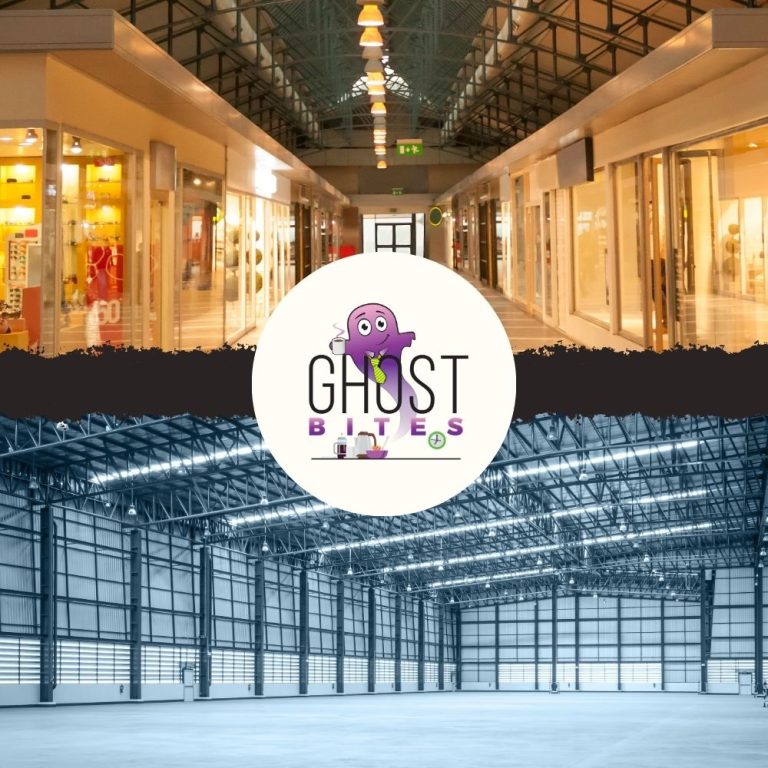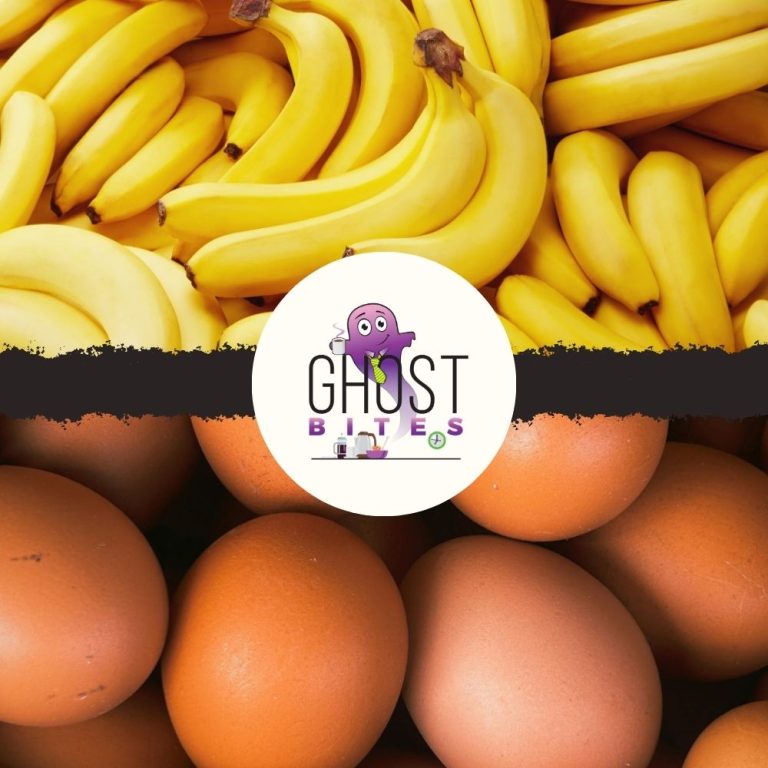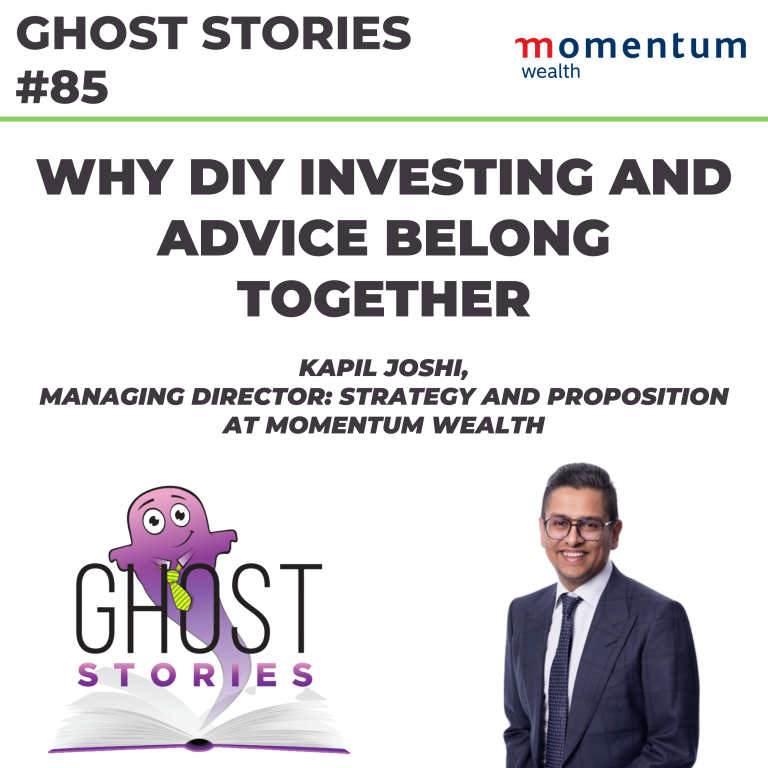Listen to the show using this podcast player:
DIY investing is all the rage and certainly has a place in the market, but so does financial advice. As a new generation of investors power through the market and look to build on the knowledge and wealth gained in recent years, there’s an opportunity to pause and consider whether it wouldn’t be better to do this with a broader financial plan in place. After all, you might love decorating a home, but wouldn’t you still use an architect to design it properly?
Drawing on the benefits of DIY investing and financial planning leads to a best-of-both-worlds approach. You can have fun with investing and do so with the safety of guardrails provided by a proper financial plan. Kapil Joshi, Managing Director: Strategy and Proposition at Momentum Wealth, joined me on this podcast to talk about how these worlds should co-exist for investors who want to take a more active approach to their wealth creation.
Momentum Wealth is part of Momentum Investments and Momentum Group Limited. Momentum Wealth (Pty) Ltd is an authorised financial services provider (registration number 1995/008800/07, FSP number 657). Momentum Metropolitan Life Limited is an authorised financial services and credit provider (registration number 1904/002186/06, FSP number 6406).
You can connect with Kapil on LinkedIn here.
Full Transcript:
The Finance Ghost: Welcome to this episode of the Ghost Stories podcast. It’s been a long time coming. A very busy man to pin down to get on this show, but I think it’s going to be worth it because we have some very cool stuff that we are going to be speaking about.
My guest on this podcast is Kapil Joshi. He is the Managing Director of Momentum Wealth Management. That’s why he’s so hard to pin down – because he’s doing so much cool stuff. Kapil, thank you so much for making the time to be on the show.
We are going to have a really fun chat about not just the rise of DIY investing, but also the broader framework in which that is happening and how people should think about getting a financial advisor involved, where they need to potentially get that expert help, where they can maybe do some of it themselves.
I think this is a very important discussion obviously with where the world has gone, and of particular relevance to the Ghost Mail audience, which is filled to the brim with DIY investors. So, Kapil, thank you so much. It’s lovely to have you on the show.
Kapil Joshi: Thanks, Ghost, it’s an absolutely wonderful honour and a privilege to be here with you. I agree – lovely subject that we’re talking about, the rise of DIY investing. Looking forward to sharing some thoughts and insights the way we see it from Momentum Wealth.
Having said that, I just want to really get it off my chest: we do believe in financial advice, but we will continue to speak about it in a way that helps your audience to understand the nuances and where we believe DIY investing can be beneficial as well. Great to be here and looking forward to the chat.
The Finance Ghost: Yeah, absolutely. To be clear, I think financial advice is absolutely key and that’s exactly why we’re doing this. I’ve said it on many a podcast, not just this one: it’s so important to recognise that you wouldn’t go and play professional sport without a coach. You wouldn’t necessarily go and have great success at the gym unless you do the research and maybe get a personal trainer involved, etcetera, etcetera. Why should it really be any different with your money? It can just help you so much and we’re going to talk about some of that stuff today.
What might be a nice way to understand it is if we use the analogy of someone furnishing their house. Bear with me. You may well have great taste and you might be willing to do the research yourself on where to get fantastic furniture at the best price and everything else (I’m very lucky that my fiancé is amazing with that, so maybe that’s a very personal example), but we wouldn’t build the house ourselves. We might choose the furniture, but we’re not going to go and build the house ourselves.
A lot of people might say, “Wow, this is not for me. Let me rather get some help on how to furnish a home.” This is why interior designers exist. It’s not that different when it comes to financial advice, right? It’s about understanding where your talents lie, where you want to apply your own time – and your time comes at a cost, it’s not for free.
DIY investing doesn’t mean you went and looked at 10 stocks, threw darts, hit some, and everything went well (that happens very rarely in an extremely bullish market). DIY investing means doing the work. That’s the trade-off that people need to use. What are your thoughts on that analogy – do you think that’s a pretty accurate reflection?
Kapil Joshi: I think you’ve used a brilliant analogy to describe the fusing of doing it yourself versus the role of advice in the context of your housebuilding example, so let’s keep it there.
If you think about the role of an architect or an interior designer – depending on which one you use when you’re building a house – you might not need all of the services of either of those individuals, but at different points there are questions you might have. There are technicalities around whether this suits the way the house is being built and the context of that process. So in that regard, the roles of financial advice often provide similar nuggets at different points in your investment or savings journey that are important to take into account.
With the analogy of building a house, let me go to myself: I am not an architect by trade and I don’t have any clue from a creative perspective how to set up any room in the house. I don’t think we have that skill, so in my case I’m definitely…
The Finance Ghost: See, it’s good to know these things!
Kapil Joshi: …going to be outsourcing that. And why it’s important is because you care about the end result. You know what you’re trying to do – when you build a house, there’s a goal in mind. There’s a point at which it might just be you and your wife, it might be to establish something for your family. Ultimately, the goal is to ensure that the roof over your head services the various needs that you have in a way that meets your standards, in a way that also talks to your wants and desires in terms of the things that you have.
Take a guy – obviously our man caves are important to us! Having a setup that allows you to have your PlayStation close by, a big TV, and to ensure your mates are catered for when you have them over – it’s important. In a similar way, I think of financial advice in exactly that context.
But I think it’s important that we recognise that there is a place sometimes for doing things yourself. I’m a firm believer in the investment analogy (it’s well-used in our industry) that says there is no better time to start saving or investing than now. So the opportunity to just do so and get those building blocks in place for a longer-term investment journey is the most important requirement in a process like this. But at the same time, if you start to think about when things get more complex (and I’ll give you many examples of that as we talk) then the role of financial advice becomes more material.
I like your previous example where you spoke about the role of a coach when you go to something like a gym. Think of a financial advisor in the same way – they are there to put the guardrails in place to prevent bad behaviour that all of us have.
I just want to quote a stat that we’ve seen in a recent study done at Momentum which is: those clients that have financial advisors end up having 9.5x more investment value attributed to the investment. Which actually once again just demonstrates the value – the tangible benefit – that financial advisors give to clients in navigating what is often not just a once-in-a-year kind of exercise, but through the lifetime of any individual client and their family.
The Finance Ghost: Kapil, I’m so jealous of you talking about PlayStation rooms, dedicated mates rooms. You must be up in Joburg, because in Cape Town (as we all know) everyone has to sleep above their toilet basically in these homes that are like a third of the size of Joburg for 10x the cost. But such is life. At least we have a pretty view and a nice mountain, so we go with it. Semigration – people are chasing that and continue to chase it, although that is slowing down a bit. That’s been one of the trends in South Africa in recent years.
Another trend of course has been DIY investing and it really has been something to behold as this has come on stream. Low interest rates during the pandemic really helped. I mean, I saw it firsthand. I started this business five-and-a-half years ago, way more by luck than design. It sounds like genius-level stuff that I picked this time where everyone was interested in markets, etcetera, etcetera – I just got very lucky, I’ll be honest, and responded to the opportunity that was there to then accelerate it and really grab it. It was amazing to see just the amount of interest in stocks all of a sudden.
Sasol was the classic one. All the professional investors were saying, “No, don’t touch Sasol.” And for good reason. New retail investors went, “Not a chance! This is Sasol, they’re not going anywhere. I’m going to dive into this thing.” And then Sasol went bananas. People who sold made a lot of money and those who didn’t sell have ridden it all the way back down.
So, DIY investing – I think it is a fantastic hobby, I really do, because there are so few hobbies that pay you. How many hobbies do you know that make you money as opposed to cost you money? I can speak to my own hobbies here: they definitely don’t make me money. So, I’m always very encouraged by people who say, “You know what? I want to take some of my money and I’d like to go and learn to invest. I want to read the company reports, I want to follow the news. This is something I’m interested in.” I think that’s such healthy, just excellent financial behaviour.
But even then, even doing it in that healthy way, you’ve got to have this broader plan. You’ll have some good views for us here on how you mitigate some of these risks. You’ve touched on one or two of the values that a financial advisor can bring and that “coaching” kind of mentality. I’m keen to see some further thoughts from you around that.
I guess the most damaging kind of behaviour would be people who almost treat it as gambling. They’re not really thinking, “This is a hobby where I’m going to go and learn the markets.” It’s just, “Let me throw some money at the markets and away we go.” Almost like the sports betting surge that we’re seeing in South Africa. So, let’s dig into this a little bit more. Just the way that this all works together, this whole ecosystem – what are your thoughts on that?
Kapil Joshi: So, let me just say: yes, I am from Joburg. That’s the first answer. You made an assumption, but I am from Joburg.
The Finance Ghost: You and your PlayStation room. Amazing.
Kapil Joshi: And swapping out the mountain means we need to find other forms of entertainment, right?
The Finance Ghost: 100%. I grew up there, I know. I can visualise that room!
Kapil Joshi: Let’s just get that out of the way. Back to DIY investing. Before we talk about financial advice again, let’s just go back to what DIY investing really is. The idea of doing it yourself and beginning to invest in the way that you described (and, using your Sasol example, I agree wholeheartedly with you in terms of the benefits of that and the financial behaviour displayed by customers) – where does it come from?
We live in a world right now where (from a generational perspective) we’re seeing a much younger audience that is starting to have curiosity about the idea of investing and saving, given that they know of its importance. Obviously they’re studying about it a bit earlier on in their secondary and tertiary education in a way that at least puts the question top of mind for younger audiences.
Why I also think that’s relevant (not to say that it’s only for younger audiences) is that the rise of technology means investments and savings are much more accessible than they’ve ever been in the past. Now, if you think about the typical retail shopping experience online – it’s the one-click experience, it’s understanding your individual requirements and nudging you towards the things that you purchased in the past, and so on. Investment processes are starting to establish the same. You can see why there is a rise, then, in the do-it-yourself mentality in individuals’ investments and savings.
And I’m going to echo what I said earlier – I’m all for that. I actually think it’s great that we have more people investing and saving because the means have obviously been made a lot easier, in terms of getting access to it. But at what point does doing it yourself start to be fraught with some risks? The perils of just trying to chase market performance?
You used Sasol. I think Bitcoin is another great example that we see, perhaps less of an investment hypothesis – I think it’s important that we recognise where the capability is. But at the same time, I think it demonstrates the speculative nature and the dangerous behaviour that certain asset classes or certain investment types can present you with. Just chasing the next best return is probably the worst thing that individual clients and customers can do for themselves because ultimately, at some point, you’re not going to be able to get it right.
This is not about investment jargon, this is not about the technicalities – I don’t want to hide our industry behind those things. But there are professionals and experts that look at this on a daily basis, that understand the different elements, and this is where I want to bring it back to the role of financial advice.
So, very basic investment terminology would suggest that if the one-click experience looks like buying something like tax-free savings products that are invested in eight or nine funds only, I think doing it yourself is okay. I think it’s reasonable to expect that that is the case.
But as time horizons increase beyond the short term, let’s say beyond 3 years plus. As your different needs, wants and desires from an investments’ perspective take shape. As you look to perhaps get married and start to fund your kids’ education either locally or globally, or you start to plan your own personal retirement – that’s where the investment opportunity set becomes much wider. Now we start to talk about – in the platform world – the language of product wrappers (that’s really just code for whether it’s a retirement annuity, an endowment, or a tax-free savings product). So, already you open up product selection opportunities.
At the next level, you start to open up investment component opportunities. This expands beyond 2,000 to 3,000 funds in the local market alone – if you think globally, that is well in excess of 15,000 different investment components. How are you expected to navigate choice as an individual and make the right decisions as soon as we move into the space?
In summary, I believe in the idea of DIY investing to get yourself going, but at some point it becomes too complex to be able to manage by yourself. That is the point at which it’s the perfect opportunity to engage with a financial advisor of some sort.
To be able to not only help you navigate the complexity, but (going back to my previous sentiments about them also representing themselves as coaches) also help you navigate any bad behaviour that you might have as a customer or a client when it comes to the “switch itch”, or chasing market performance, or even ensuring that you have your holistic plan well articulated and that you’re tracking yourself against that plan. That’s the role of the financial coach in this particular journey. I hope that helps.
The Finance Ghost: Yeah, look, there’s a lot of good stuff coming through there. Words like “curiosity” are exactly right – that’s something that drives a lot of people’s interest in the market and their initial steps into it. The one thing then (or just the way the entire ecosystem works, it is what it is) is the type of content that people latch onto. I know this from experience: they want to read about stocks, right? That’s the exciting thing. “Tell me about Sasol. Tell me about Anglo American. Tell me about this interesting mid-cap that I’ve actually never heard of and know almost nothing about.”
And that’s all fine as long as you engage that content in a very healthy way and you’re getting it from the right sources. And there are many – I like to think I’m one of them, but there are many.
But the wrong source would be your typical case of someone who suddenly wakes up and they’re a TikTok financial influencer and they have some great views on “5 Hot Stocks”. This person has never been in a professional investment firm or a boardroom in their lives – what do they know about picking stocks, actually? And they come and they go.
There were so many who arrived during COVID because it’s just that response of “What’s going on in the market? Oh, people are interested in this content. Let me create this content.” Today I’m a stock expert. During the Cape Town drought, these same people were borehole experts – it’s just that kind of mentality.
So, you’ve got to be super careful about where you get your content. And there are a lot of really, really good places. I think if you engage with the right quality content around stocks, you’ll quickly see that it’s not easy – and that’s the point. There’s a reason why a small percentage of active fund managers beat the market over time. A very small percentage. And these are pros doing it all the time. So, I would rather look at it and say, “Look, it is very hard. And that challenge is part of the appeal.”
The cool thing is that if you do the DIY investing with some really good guardrails around your broader financial plan, then (even if you underperform the market) what you’ve really done is taken a portion of almost a hobby budget and said, “Okay, let me invest it.” It’s almost in excess of the minimum you should be putting away that your financial advisor would help you identify.
And then – I don’t want to say it doesn’t matter how that money does, but it kind of doesn’t matter. Because (if you’re saving enough and you’ve got those guardrails in place), if you have a really bad year with your DIY pot and you learn from it, then yes, you lost some money – but you would have spent that money on something else anyway. At least now you’ve given yourself a chance for it to actually go up. And you know in the back of your mind that everything’s going to be okay because, long term, my plan is fine, I’m putting money away in the right vehicles. And I guess that also just unlocks the ability to then have a healthy relationship with your DIY investing.
So it’s the same way I manage my hobby budget every month: I spend money on my hobbies, but I know how much I can spend and so I can spend it with zero guilt because I’ve figured it out. I don’t even second-guess. It’s like, “This is what I can spend every month – done.” I think that’s quite a healthy way to understand your DIY investing.
And that’s a big role of the advisor, right? To help you with these guardrails.
Kapil Joshi: Yeah, I think you used a key word for me in your description now, Ghost, and that is “budget”. I want to latch onto that as perhaps something that often gets overlooked in the journey that we are talking about today.
The idea of having a budget in the first place is something many people struggle with. In fact, the stats indicate that half of the South African population, from a propensity and affordability perspective (obviously there are good reasons for it) don’t have a budget. And what we’re speaking about for today’s subject is critically identifying some of the gaps that need to be closed as well.
So, even before a financial advisor can come into the picture, having a budget is such a key thing and a key component because what it says is: at the end of the month, when you get your salary, how much of that net salary goes towards different things that need to be funded in the household? Or for the different aspects of serving your family’s needs (if you do have a family)?
And what’s important to highlight in that process is that there is often very little left that ends up being utilised for probably the wrong things in the first place. You call it a hobby budget. Hobbies are great, and I think if you extend those hobbies into learning and sparking curiosity into different fields and so on: awesome. But at the same time, it’s important that we try and look at the opportunity to stretch rands as far as they can be stretched.
This is where the idea of having a budget and ensuring that you can have X amount of money set aside at the end of every month for even the opportunity to go the route of doing it yourself from an investment perspective – the stocks that you have an inkling to, or the unit trust manager that you might align to in terms of philosophy and/or style, or whatever the case might be – at least you have the opportunity, then, to start to participate in market growth. Now, we’re not even in the space of trying to meet inflationary objectives that you might set for yourself in terms of that investment, but at least you’re putting money away. So I think that’s an important dimension.
The second element that I want to call out in terms of this is what you spoke about: the role of finfluencers and getting stock tips or bad advice from the wrong sources. I do believe that these new individuals, via social media, have a role to play in sparking interest and curiosity (going back to our earlier points). But at the same time, it’s important that you recognise that your personal requirements, your personal needs, are unique to yourself. Not everything you hear or see on social media or via the next best finfluencer on TikTok is going to be right for your circumstances and for your needs.
This is where I think it’s important to bring in the idea of something like a risk profile, which is a good example of what a financial advisor would do for you in a set of circumstances like we’re talking about. And that is to identify your propensity to be either risk-averse or risk-taking – in the nature of who you are as an individual, behaviourally. Once a financial advisor follows something like a risk-profiling process, they identify what your risk is as an individual and your ability to choose or match appropriate products and appropriate solutions to then meet that risk profile – that is one function that a financial advisor would play to ensure that you are in the right place.
That’s such an important example to illustrate the idea not only of the importance of your personal needs, but also of (once your personal needs are understood) matching that to an appropriate individual like a financial advisor that can help you to ensure that you are in the right place for your personal circumstances and for your risk profile. That’s a great example of illustrating why not to just listen to the next best finfluencer.
And by the way, Ghost, I think your content is amazing. I’m sure that many individuals are taking a lot of lessons learned, at least from your podcast – which is real and also illustrates what the financial industry is about.
The Finance Ghost: Thank you, that’s very kind. I wanted to touch on something you said there which is really important: that a holding that’s good for one person is not necessarily good for the next person. That is exactly why – and I’ve been asked to do this a million times before – that is the real reason why I don’t publish what I hold.
Because I know that even if I publish 98 pages of disclaimers next to it and remind people in big red writing (although it would probably be purple) to go and get a financial advisor or to do their own research, I know what’s going to happen. It’s going to be, “Oh, this guy owns these stocks. I like his writing, I’m going to own them too.” And it’s very flattering, but it’s also completely wrong. I own them for a specific reason, in a specific proportion, with specific reference to other stuff I have. I’m not going to disclose how much I have in fixed income savings, business savings, etcetera, etcetera. There’s a whole balance sheet that I’m managing. And that is exactly why I do not publish: “Oh, I hold all of these things.”
It’s also why when I write in Ghost Bites – and someone asked me this on X literally just the other day, which I thought was a great question. He said, “Do you always disclose where you have a holding?” My answer was, “I always disclose it where I give a strong view on a stock.”
For example, I’ve been very vocal on something like Prosus this year, because I bought it right at the beginning of the year, I disclosed that at the time and I’ve tried to walk people through that journey because, at the end of the day, Ghost Mail is really just my notebook on my own market activities. It’s just that a lot of people like to read it, which is great. And then we get to do cool podcasts like these, which is fantastic. But I’m always scared that a company comes out with an almost non-event piece of news and it’s just one of my portfolio positions for the long term and now I say, “Yeah, I have this stock.” What do people do with that information?
That definitely doesn’t mean, “Oh, it’s necessarily a great buy right now.” It just means, “I have it right now.” That’s not the same thing at all. So, that’s the difficulty and where I personally get very nervous when I see very hardcore stock picking-focused social platforms. There are one or two really good ones – there are some really, really good bloggers out there who are particularly excellent at that – but on the whole it’s just not good.
And you never hear about these people’s losses, right? That’s the other thing we have to be super careful with when it comes to social media content. There are a handful of people who are willing to say, “Actually, I got this one horribly wrong.” I always do it – if I’ve lost money on something, you’ll never see me backtrack and say, “Oh, no, I never had this stock.” No, we all make mistakes. There’s no world in which you get 100% of them right. Any good trader will tell you that, actually.
So, again: it’s about healthy engagement with content. And I think having a voice of wisdom, like a financial advisor alongside you in this journey, just helps you so much with this. Because every decision you take in the market is an active decision. You touched on tax-free savings earlier and putting it in a spread of ETFs and everything (which is something absolutely everyone should do – max their tax-free savings every year). But what do you buy? How do you choose? The underlying ETFs might be passive, but the decision of which one to buy is active. The decision to do tax-free savings is an active one, where you need to take into account your liquidity and everything else.
So there are all these little active decisions. Some of the underlying end stuff might be passive, but everything else is active. And that’s why getting an advisor helps you. It helps you with understanding this stuff, right?
Kapil Joshi: Yes, 100%. Just a few concepts to call out in what you were just describing. The first one is sentiment-based investing, which is probably the worst thing one can do. So, just listening to what works and what’s winning in the market (once again, going back to what I said earlier) might not be right for your personal circumstances. I’m just going to emphasise that point once again. And that’s this whole idea about taking what you hear and what you read and putting that down for yourself – that’s effectively called sentiment-based investing, which is where, once again, the role of financial advice comes in.
The other one that I want to call out (which isn’t something that you specifically spoke to, but is important in the context of what we are discussing) is diversification. It’s not something I think we’ve actually alluded to so far. The idea that the market has so many unique offerings and capabilities available to you, to fulfill your personal circumstances, is a key element in ensuring that a holistic plan meets your individualised needs. Let me explain a little bit more what I mean by that.
If you use your stock example, that’s called 100% equity exposure if it was only in that particular investment. And ultimately, if you are a risk-averse investor, 100% equity-based exposure is completely incorrect for you, because there aren’t any tools of diversification in your overall portfolio to help you with your risk aversion. This is once again where the role of financial advice comes in. The idea that an individual wants to hold a stock – Prosus, in the example that you mentioned – is something that an advisor listens to. They take that into account, in the holistic consideration of the individual in front of them when that financial advice process is taking place, and determine the inclusion of that alongside many other elements.
Let’s just go to the process of financial advice in the first place, because that might explain to your listeners exactly what to consider. The idea of financial advice starts with the financial advisor getting to know you. The idea that trust needs to be established – between you (the client) and the advisor – is the only basis under which you’re actually going to share your financial picture and choose to invest with that individual. So the relationship basis is where it begins.
Once that is established and you can have an element of trust with the advisor, it starts to move into the space of what your needs are, what your circumstances are, what budget you operate, and so on. So, the financial advisor determines this holistic view of the individual sitting in front of them and starts to determine how to shape their advice responses to this unique set of circumstances.
Those circumstances don’t even go yet to stock selection, in the way that you first described. It will go to something like: are there estate planning requirements that need to be fulfilled for this client? For instance, do they have a family that needs to be taken care of in the form of beneficiary nominations? A very basic example. Once again, just illustrating that you can see we’re not even in the stock selection context yet. We’re in the “let’s understand your needs and what you require as an individual first” context.
Another example that I can call out in that space is that you might, as an individual, want to be saving for retirement so that your lifestyle – when you do reach retirement – can be maintained in the way it is now. That’s a good example of what a financial advisor would ask. So, all of a sudden, this financial advisor is starting to get all of these data nuggets that indicate exactly how to think about his or her financial advice response to you.
The next part of it is to say, “Let’s go through the risk-profiling process (which I alluded to earlier) so that we can understand how to put things together for you.” It’s at this point that the financial advisor might, in that example, say, “Okay, I’m happy to include your Prosus requirement, but given the risk profile and given your other sets of unique circumstances, I think it only makes sense to have a 5% exposure to this particular asset class in your overall portfolio.” That might serve your need and interest as a client in your ‘hobby budget’ as you refer to it, but the 95% completion of your holistic plan might need something like a guaranteed solution. It might need something like fixed income or money market fund exposure to ensure that your overall risk profile, your overall needs, your overall return objectives that you’re setting for yourself to achieve your goals, are well catered for in the form of financial advice.
So, in the steps that I’ve explained, you can see that I shifted the conversation (and I hope your listeners are acutely aware of that – I know they are investment savvy individuals themselves) away from just: What have I heard? What stock selection bias do I have? What is it that I see and read that’s going to confuse my overall financial picture?
By establishing the role of financial advice, you get clarity and you get an opportunity to then also look at the broader suite of capabilities that might allow for the diversification benefit to be achieved for your set of circumstances. And I think that’s very important.
The Finance Ghost: Yeah, I mean the great example would be if you play cricket. You go to your coach and say, “I’m trying to work on this very specific shot. I’ve tried to teach myself the whole way through, and now I need a bit of help.” The financial advisor’s first thought is, “Never mind that – should you even be playing cricket? How many times a week are you playing cricket? Let’s talk about that before we even get down to the specifics of this particular shot or the way you hold the ball.” And that’s a very important point.
A financial advisor is so much more than just “Oh, should I buy Sasol?” That’s not actually what it is. And that’s a really important thing for people to understand.
I want to talk about some of the Momentum Wealth platform-type stuff before we bring this to a close. But just while we’re on the topic of the financial advisor, specifically. You’ve given a lot of great insights into stuff like the relationship, what they actually do, how important that stuff is. What are some of the other key qualities that you think someone should look at when they’re choosing a financial advisor? This is obviously a topic very close to your heart at Momentum.
I’m keen to understand what you would recommend in terms of someone (because they hear this all the time) – “Find a financial advisor.” Okay, great – what do I do? What does that actually look like in practice? Because I think that’s a stumbling block. People hear that all the time, but it’s not necessarily that easy to actually do it.
Kapil Joshi: So before we get to the wealth platform stuff (which I’m also keen to have a conversation about because this is where partnership with Momentum Wealth, through something like financial advice, provides really strong capabilities to clients and customers in really helping them to deliver their financial value). There are four things I’m going to say to you, and some of it’s going to be a repeat of what I shared earlier.
The first thing I want to highlight is that I do not personally question the efficacy and the role that advisors play. I think they’re amazing in what they do and they add value, as I’ve indicated earlier, to clients in achieving their financial objectives.
So the four things that I want to highlight are, with the first one: When it comes to sometimes the uncomfortable or personal discussions (I said it a little bit differently earlier), like budgeting – the relationship with an advisor will undoubtedly need an element of trust. So finding someone that you can trust and freely engage with around your financial picture is critical.
The second one is, given that each person has different life requirements, finding an advisor who understands your context, and who can work with you in your context, is key to a long term partnership.
Third, depending on the complexity of your needs, there are advisors who are more experienced in certain areas, such as when investment opportunities become more complex. Like in the example of hedge funds – it’s less about the softer side and the emotional context, and more about, factually, whether the advisor has the necessary licenses and experience.
Ultimately my fourth point, which sums it all up, is that it really boils down to whether you like the person, whether you can trust the person, and whether they have the skills and tools necessary to provide a personable solution to you.
How you locate a financial advisor is a tricky thing, but often it starts with word of mouth. If you have a friend or family member that is receiving a high quality service from a financial advisor, they are more likely to recommend that individual to you. When you’re sitting and having a braai and you’re talking about stock selection (which is actually happening more and more regularly than you think it is), that’s often when the question comes out in terms of, “How is it that you are able to achieve what you do in your individual sets of circumstances around financial planning?” And that’s where the recommendation of “The advisor that I use…” is recommended. So word of mouth is the first one.
The second one is, unfortunately, probably the less accurate one – scouring social media. Scouring, let’s call them, the technology platforms available to us: websites of companies, like Momentum, that have services that they offer. So, we have a business called Momentum Financial Planning that is specifically oriented around giving financial advice and they typically represent themselves in all domains (be it on their website or social media) around the role of advice and so on.
Naturally, hashtags and all of that being utilised in searches allow you to see who’s more likely to give you financial advice, especially if you just start from scratch. But that’s a little bit trickier because, as I said – the relationship’s important. So, if you just identify, locationally, where the advisor might be close to you, it still might not be the right fit for you from a relationship perspective. So it’s important that you at least identify that in that journey of just starting from scratch and trying to go at it yourself.
And then most corporates and most financial services businesses (like ourselves) have a lot of lead generation that they consider. When direct customers come to them for different capabilities or for different solutions – at some point there’s a nudge to recommend that perhaps you’ve reached the point at which financial advice can be beneficial to you and your set of circumstances. And the pairing up process thereafter obviously becomes, in the same way that I described early on, quite a key opportunity to try and navigate.
But if I had to focus on the one that really matters, I think word of mouth is probably the one that results in the best tangible value in terms of engagement between a new client looking for financial advice.
The Finance Ghost: Yeah, absolutely. I love that answer because it just talks to how relationship-based it is, at the end of the day. There is a Momentum option for people to go and have a look, and I love the fact that it’s come up in conversation. The idea here is to make sure people are thinking about this correctly – find the advisor that works for you.
If that’s a momentum advisor, great. If it’s not, at least you’ve got an advisor and you’re doing the right stuff. Just a shout-out to my friends at Moneyweb who I do a podcast for every week: they have a lot of financial advisor listings on their sites. I was just thinking about that now – it’s also not a bad place to look. I’ve always loved the fact that they’ve done that. I think that they do a lot of really good stuff around just helping people find advisors, getting that sort of advice, which is always nice to see.
So, let’s move on then to the Momentum Wealth Platform. So this is where I very quickly start to run out of talent and knowledge – I’ve never worked as a financial advisor. I personally often see these discussions around all these fancy platforms and wrappers and everything else. And then I have to remind myself that’s not the thing that came off the lollipop that my 5-year-old just devoured! So, we need to do a little bit of…not necessarily jargon busting here, but I’m keen to understand some of this stuff.
Let’s start with the Momentum Wealth Platform, because that word ‘platform’ gets used a lot in financial services. It’s pretty much everywhere. What does that actually mean and what difference does it make to the end user – the person listening to this right now, who’s thinking, “Maybe I should speak to an advisor?” instead of punting everything on Sasol all the time. What does the Momentum Wealth Platform actually mean to that person?
Kapil Joshi: I’m going to answer this with a big smile on my face because we get it a lot in terms of industry jargon and our responses to it. So, let’s demystify it very quickly. A platform is really just a code word for the idea that you have a central administration mechanism available to you where you can house your products (things like retirement annuities, endowments) and your solutions or your components (things like unit trust funds, share portfolios, hedge funds, or whatever the case might be). What a platform does is it’s able to consolidate your product selection as well as your solution selection, report to you, via your advisor or to you directly, in a way that allows you to see the benefits of a combination of your products and your solutions.
The other idea that platforms bring you, which I also want to highlight, is the fact that (and so far we’ve been having a conversation that’s quite general, but) typically in an investment journey you might have local exposure and you might have international exposure as well.
At Momentum we have Momentum Wealth Local, which is our local platform that gives you rand-based exposure. We also have Momentum Wealth International, which gives you hard currency exposure in a currency like USD or GBP, and that allows you to externalise assets.
Now both of these essentially resemble the platform capability that we have. And just a reminder of what I said earlier – it’s the housing, through an administration mechanism of your products as well as your solutions, to be able to consolidate between your local and international holdings in a way that allows you to now have a one-stop shop essentially where all of your investments and savings are housed. So now, essentially, you don’t have to go to a different place if you want a share portfolio, you don’t have to go to a different place if you want a unit trust fund – you can have all of that in one single investment and therefore contract that one single investment against your goals or objectives that you set for yourself in terms of that particular investment approach.
So the long and the short of it is: let’s kind of debunk all of the terminology and the jargon. Forget the words ‘platforms’ and ‘wrappers’. It’s a place you can come to start your investments and savings journey in a one-stop shop manner that allows you to have access to great reporting, great service, and a fantastic range of products, as well as solutions.
The Finance Ghost: So let me ask you, while we just dig into some of this platform stuff. I think some of the responses people have gotten to a point where they give almost automatically is – they’ve almost become allergic to costs and fees, right? This must be something that you deal with all the time. We’ve kind of gotten to a place where people almost expect this stuff for free, just about, and anything that’s not free is painful, you know, and obviously that’s not realistic or real life. But there’s been a lot of (really quite correct) content that’s gone around online, around the impact of fees on returns, etc.
I guess it’s a cost benefit then at the end of the day. If you get your stuff into the right structure, if you then have the right discipline, etc. – it’s going to cost you something. But net-net, it should make you something.
And I think that’s where a lot of your stats come from. The benefit of actually doing this is yes, Momentum needs to eat, but you’re going to eat more as well on average through getting the advice and having the right platform, right?
I think that’s maybe a nice place to start to bring this to a close. Just understanding – we’ve done some really good stuff around how cool DIY investing is – how important it is to do it in a broader framework and get those guardrails in place. Understand that your advisor is so much more than your stock-picking mate at the braai. This platform is out there. So let’s tie it all together and just talk about the costs of doing this, but really the benefits that come through from doing it.
Kapil Joshi: I don’t mind the conversation around costs, but I want to shift it to value. It’s important to recognise that the role of platforms isn’t just a cost line in what clients are willing to pay via the advice that they receive, or even if it is just by themselves. It’s about the value that is extracted for the cost that is levied. And I think it’s important to understand why those charging structures look the way that they do in a total value chain context.
Remember – there’s really three main buckets of costs when you enter via platform. The first one is the advice fee you pay, typically, if you are generating some form of advice. Then there is the administration or platform fee – that is where a business like Momentum Wealth would come in for certain services that it offers and services that are often at scale, which is not something that can be replicated by clients in their own right (and I’ll unpack some of that). And then finally, the investment management fees for either the share that you own or the unit trust that you’re exposed to – that also comes at a fee. Which ultimately results in very simplistically, these three components coming together for the total fee that a client would ultimately pay.
The value chain basis under which we are operating in South Africa right now is that platform administration margin has been under pressure for a period of time and hovers somewhere in the region of around 30 to 45 basis points, or 0.3 to 0.45% per annum for that specific component in the total fee value chain.
Now, if you think about it in the biggest scheme of what it is that you’re trying to pursue as an individual investor or via something like financial advice, when I refer to the value that the platform gives, I’ve given you some instances of it in my previous response around debunking what a platform is.
The first one is consolidated reporting. To be able to have a one-stop shop that allows you to have access to multiple components, multiple products and so on, and to give you a consolidated view of that so that you can have better conversations about your goals and your objectives. And to re-orientate it I think is key.
In addition to that, the platforms work hand in hand with financial advisors in the sense that the service that we offer and the service that advisors expect from a business like Momentum Wealth has to be world class. This is about the basics like trading and settlement. You don’t want to be out of the market for a period of time when things are happening that might be driving market prices. The role of the platform is then very much to circumvent some of those issues so that you, as an investor, don’t have to worry about that and can have a sleep-at-night factor – that’s critically important.
Another area to highlight is that you can have what I referred to earlier as both this local exposure and this international exposure. If you start to think about intergenerational wealth (which might be a topic we want to speak about in a future podcast) there are things that one needs to consider in the holistic planning process – both around product selection, and also the movement of money. All of a sudden, it’s no longer just dealing with a single investor. It might start to be that you’re dealing with the broader family and the benefits of dealing with the broader family.
In our recent Momentum Wealth International launch, that we just traveled the country to share, we’ve now introduced a concept called family aggregation from a pricing perspective. This means that all contracts in this family grouping (for your direct family as an example) will benefit from one single fee structure, which can reduce fees to the maximum of around 40% in terms of the discount that is offered on a platform like Momentum Wealth.
So you can see the additional benefits that the platform offers – and I’m just calling out three or four examples now, there’s way more that we can spend time talking about. The attachment to the fee that we charge should start to mean something less to clients because of the value that is being extracted from the platform for what that fee relates to. And I firmly stand by that.
I think we offer great capabilities to not only support and benefit the financial advice process, but ultimately to ensure that clients do not pay a fee that doesn’t result in value for them and that, at the same time, we stand hand in hand with them in the long-term investment objectives in a way that allows them to meet those objectives. We do not believe that the fees that we levy are value-eroding in that regard.
The Finance Ghost: Yeah, I think that’s very fair. It’s like every service in life. It’s going to cost something and you need to look at the value you’re getting from it – you need to decide if it’s going to work for you. And you need to remember that these things exist for a reason, and if the reason is not apparent to you yet, the reason will probably become apparent down the line when you possibly have some regrets that you didn’t look at this early on.
So, Kapil, thank you so much. I think we’ve dealt with a lot of really, really cool stuff on the show. For anyone who wants to learn more about Momentum, I think it’s easiest to just go to the Momentum website, right? Go and check out the wealth offerings, etcetera. Just go and dig around and learn more. We’ll include some useful links in the show notes here just to help you find the right stuff. And Kapil, thank you – it’s been a really good chat. I appreciate it.
Kapil Joshi: Thanks, Ghost. And maybe just a final note from my side: yes, please go and have a look at our website, but also follow us on social media. We post very interesting thought leadership and we share some of our insights across the wealth management industry into the broader investments industry.
That can be very beneficial to your listeners that are looking to understand a little bit more about what we offer, but to also just benefit from some of the great thought leadership by industry experts that sit in our business, whom we take great pride in at least sharing with your listeners.
Thanks, Ghost. I really appreciate being here. It was a great conversation and all the best.
The Finance Ghost: Yeah, thank you. And as a final comment from my side – well done for everything going on in Momentum at the moment. Obviously I’ve been following the stock and the story, the name. It’s doing what it says on the tin right now. There is a lot of momentum, so congrats. Keep it going.
Kapil Joshi: Wonderful, thank you so much! Really appreciate it. And I’ll definitely take that message back into the business as well. Great stuff. Thank you.
The Finance Ghost: Cool. Ciao.


















